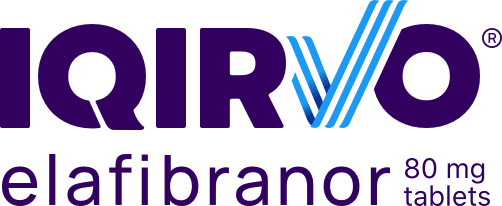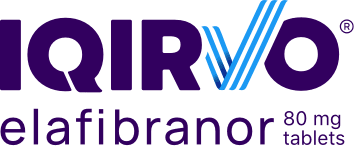A different approach to primary biliary cholangitis (PBC) treatment
IQIRVO is thought to act on multiple targets in the liver. Two of these targets are PPAR alpha and PPAR delta.a
In the liver, PPAR alpha and PPAR delta help control:


a This information is based on animal studies, and the way IQIRVO works is not fully understood.
PPAR=peroxisome proliferator–activated receptor.
Expect more from your PBC treatment
If you need more from your PBC treatment, adding IQIRVO can help.
IQIRVO was studied in a 52-week clinical trial of 161 people with PBC.
- 102 people took IQIRVO in addition to ursodiolb, and 6 people who were intolerant to ursodiol took IQIRVO alone
- The results were compared with 53 people who took ursodiol alone
Treatment goals in the trial were defined as:
- Lowering alkaline phosphatase (ALP) to less than 1.67 times the upper limit of normalc
- Decreasing ALP by at least 15%
- Maintaining normal bilirubin
13x more
people with PBC
met the established treatment goals when taking IQIRVO
compared to people who took ursodiol alone.d
d 51% of people taking IQIRVO met the treatment goals compared to 4% of people who took ursodiol alone.
In the clinical trial:
IQIRVO lowered ALP in as quickly as 4 weeks, and the effects were sustained over 52 weeks.
By 52 weeks, some people taking IQIRVO (15%) achieved a normal ALP level, compared to no one who took ursodiol alone.
IQIRVO can lower and even normalize ALP.
Itch-related results
IQIRVO was studied in people who had moderate-to-severe levels of itch defined as a PBC Worst Itch Numeric Rating Scale (WI-NRS) score greater than or equal to 4.
People taking IQIRVO reported an average reduction of 1.93 points in the WI-NRS score, compared to people taking ursodiol alone (average reduction of 1.15 points).
When asked questions from the itch section of the PBC-40 questionnaire and the 5-D itch scale:
People taking IQIRVO reported an average reduction of 2.5 points in the PBC-40 itch score, compared to people taking ursodiol alone (average reduction of
0.1 points).

People taking IQIRVO reported an average reduction of 4.2 points in the 5-D itch total score, compared to people taking ursodiol alone (average reduction of 1.2 points).
Itch was a secondary outcome of the study and results did not reach statistical significance. Data should be reviewed with caution. If you have questions about this limitation, your doctor can help explain it further.
After the trial was over,
97% of people taking IQIRVO
chose to continue taking IQIRVO in an ongoing follow-up study.
Ask your doctor if IQIRVO may be right for you
Monitoring markers of PBC progression, like ALP and bilirubin, is key to an effective PBC treatment plan. Use the IQIRVO Discussion Guide to help you talk about your treatment with your doctor.
Safety and tolerability
|
IQIRVO vs |
|
|
Weight gain |
23% vs 21% |
|
Diarrhea |
11% vs 9% |
|
Abdominal pain |
11% vs 6% |
|
Nausea |
11% vs 6% |
|
Vomiting |
11% vs 2% |
|
Arthralgia |
8% vs 4% |
|
Constipation |
8% vs 2% |
|
Muscle pain |
7% vs 2% |
|
Fracture |
6% vs 0% |
|
Gastroesophageal reflux disease |
6% vs 2% |
|
Dry mouth |
5% vs 2% |
|
Weight loss |
5% vs 0% |
|
Rash |
5% vs 4% |
Tell your doctor about all of the medicines you take, including prescription and over-the-counter medicines, vitamins, and herbal supplements.
Once-daily dosing at a time that works for you
IQIRVO is an 80-mg pill taken by mouth, with or without food. It can be taken at any time, as long as it's the same time each day.
b Ursodeoxycholic acid, or ursodiol, may also be referred to as UDCA.
c The upper limit of normal, or ULN, is the high end of a normal range for a lab value. When assessing a person’s response to treatment for PBC, the definition of response may include an ALP level in relation to the ULN (for example, an ALP level of 1.67 x ULN).

